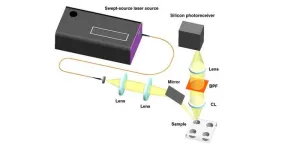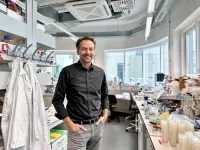(Press-News.org) Mixing livestock and crops, integrating flower strips and trees, water and soil conservation and much more: Massive new global study led by the University of Copenhagen and University of Hohenheim, has examined the effects of diversified agriculture. The conclusion is abundantly clear – positive effects increase with every measure, while negative effects are hard to find.
Laura Vang Rasmussen of the University of Copenhagen can finally wipe the sweat from her brow. For the last four years, she has served as the link between 58 researchers on five continents and as lead author of a major agricultural study which gathered data from 24 research projects, along with colleague Ingo Grass of the University of Hohenheim in Germany.
The hard work has finally paid off. Their research article, just published in the prestigious journal Science, delivers a clear and well-founded message to agriculture:
"Drop monoculture and industrial thinking and diversify the way you farm – it pays off," as Laura Vang Rasmussen from the Department of Geosciences and Natural Resource Management puts it.
"Our results from this comprehensive study are surprisingly clear. While we see very few negative effects from agricultural diversification, there are many significant benefits. This is particularly the case when two, three or more measures are combined. The more, the better, especially when it comes to biodiversity and food security," she explains.
The researchers see the greatest positive effects on food security, followed closely by biodiversity. Furthermore, social outcomes in the form of well-being also improved significantly.
Among the many strategies adopted, livestock diversification and soil conservation had the most positive outcomes.
Yields not hampered– with clearly improved food security
According to the researcher, previous studies investigated either the socioeconomic or environmental effects of agricultural diversification. This study investigates effects across the board, with surprisingly positive results.
"Agricultural diversification has been accused of perhaps being good for biodiversity, but having a few negative aspects too – especially with regards to not being able to achieve sufficiently high yields. But what we actually see, is that there is no reduction in yield from diversified agriculture – not even when we include data from large-scale European agriculture," says Ingo Grass of the University of Hohenheim.
In fact, the figures demonstrate that in the case of small farms and farms with lots of cultivated land in the surroundings, more diversified agriculture can significantly promote food security. This, according to the researchers, could be due to a number of factors.
"One example is fruit trees planted in maize fields in Malawi, which can help farming families improve their food security through improved diet and nutrition. Partly because they eat the fruits themselves, and also because the trees generate extra income when their fruits are sold at market – income that provides small-scale farmers with purchasing power for other foods," says Laura Vang Rasmussen.
Massive amount of data revealed win-win outcomes
All 58 of the study’s authors participated actively in its design to attempt a robust and credible interweaving of the many data sets spread across the world – from maize production in Malawi, to rubber trees in Indonesia, to silvopastoral cattle farming in Colombia and winter wheat in Germany.
"The study unites many different situations from the many data sets that we used. In Malawi, we have data on food security expressed, for example, in the number of hungry months for small-scale farmers where they have been short of food. Such metrics are not used for, for example, large European farms, where we have yield data instead, such as winter-wheat yields in Germany, explains Rasmussen, who continues:
"But the point is that when we look across all datasets, our results show that applying more diversification strategies improved both biodiversity and food security, and didn’t have a negative effect on yields."
The researchers also investigated which diversification strategies result in 'pairs' of favorable “win-win” outcomes. Their data showed that strategies beneficial for biodiversity also improved food security.
They also witnessed win-wins for biodiversity and people's well-being.
Effects with and without natural areas in surroundings
To investigate whether the surrounding landscape influences the effects of diversification strategies, the study also took three different types of landscapes into account: heavily cultivated areas with very little nature, an in-between “simple” category with mixed landscapes, and areas where the landscape around farms is characterized by nature that is relatively pristine.
Until now, the thesis has been that diversified agriculture would only have a very good effect on biodiversity for in-between or “simple” type landscapes, which is also where the researchers recorded the greatest effects. But in fact, the study shows that diversification strategies make good sense in many different contexts. Even in landscapes with more nature, there are positive effects to be gained with regards to biodiversity.
"It's a simple message to be able to pass on to different types of farms – whether it is small farms in South America or Africa or advanced European agriculture, there are lots of positive effects to be gained by introducing these various strategies – and very little to fear. It is very positive that so many different things can be addressed, and that, in general, positive biodiversity outcomes seem to go hand in hand with well-being and food security," says the Ingo Grass.
This is backed by Professor Zia Mehrabi from the University of Colorado Boulder and Professor Claire Kremen of the University of British Columbia who are the joint PI’s of the study:
“This is an important achievement in bringing together some of the world’s foremost agricultural researchers to synthesise the data needed to back policy on driving the transformations that are needed in farming landscapes,” says Professor Zia Mehrabi. He is joined by Professor Claire Kremen of the University of British Columbia:
“The study shines a light on real-world farming conditions in many different regions and contexts worldwide. With the clear positive outcomes of these diversification strategies it suggests that governments and businesses should invest more in incentivizing farmers to adopt such strategies, which will in fact help them while also promoting agricultural sustainability and planetary health,” she says.
*
Extra info: Few negative effects may be temporary
The study found very few measurable negative effects resulting from diversification efforts. One of them was in connection with the category "non-crop-diversification", e.g. planting of trees on farms. Data show that these activities can affect farms specifically with regards to well-being – or quality of life, but this may be a transitional period.
"We cannot say with certainty what is driving this, but it may be due to the increased labour required to plant and maintain trees on farmland. This could manifest itself as a negative effect on well-being. One explanation could be that it takes time to reap the rewards of having trees on farms. So, whereas planting trees takes an immediate toll on the labour requirements, it takes years before the fruits of the trees can be harvested," says Laura Vang Rasmussen.
Extra info: Unique study design involved researchers worldwide.
With 58 researchers scattered around the globe, all of whom have been involved in the design of the study and the interweaving of their 24 datasets from other studies – representing a total of 2655 farms on five continents – the research project is quite unique.
"As far as I know, this has never been done on such a scale before. Finding common indicators for these calculations, in so many different studies and diverse data, and in such a way that we were able to integrate them, has been hard work. But I think the approach may inspire future research. That the enormous amount of data we processed provides such clear results is quite groundbreaking," says Laura Vang Rasmussen.
Facts: Three types of surrounding landscapes
The study investigated whether the degree of natural habitat in the surrounding landscape moderates the effects of diversification:
Cleared Landscapes: <5% semi-natural habitat in a given landscape
Simple Landscapes: 5-20% semi-natural habitat in a given landscape
Complex Landscapes: >20% semi-natural habitat in a given landscape
Facts: Agricultural diversification: Strategies and practices
The research article has collected data on the effects of more than 20 different types of diversification practices within five broad categories of diversification.
Temporal crop diversification: Rotation, rotation including >2 crops, Cover cropping
Non-crop diversification: Hedgerows, windbreaks, flower strips, beetle banks, forage strips, other non-crop diversity
Soil conservation: Manure application, compost application, green manure application, inoculant application, biochar application, residue incorporation, mulching, nutrient mobilizing plants, other beneficial soil amendment practices
Livestock diversification: Number of livestock species, including e.g., cattle, horses, pigs, goats, sheep, fowls, donkeys, fish, and managed bees
Water conservation: Terracing, continuity of cover/roots, bunds, contour farming, other beneficial water conservation practices
Behind the research:
Laura Vang Rasmussen from the University of Copenhagen and Ingo Grass from the University of Hohenheim, Germany, are joint first authors of the study.
Professor Zia Mehrabi, at the University of Colorado Boulder and Professor Claire Kremen of the University of British Columbia are joint PI’s of the study. They helped bring together the international research team at the NSF funded National Socio-Environmental Synthesis Center, in the United States.
See the rest of the extensive author list in the study: https://www.science.org/doi/10.1126/science.adj1914
END
"Drop industrial agriculture": Major study reports that people and environment both benefit from diversified farming, while bottom lines also thrive
Mixing livestock and crops, integrating flower strips and trees, water and soil conservation and much more: Massive new global study led by the University of Copenhagen and University of Hohenheim, has examined the effects of diversified agriculture
2024-04-04
ELSE PRESS RELEASES FROM THIS DATE:
Portable swept-source Raman spectrometer for chemical and biomedical applications
2024-04-04
In 1928, Indian physicist Sir C. V. Raman and his colleague K. S. Krishnan discovered that when light interacts with matter, parts of the scattered light undergo changes in energy due to interaction with molecular vibrations, resulting in what is known as Raman scattering. The discovery laid the foundation for Raman spectroscopy, a technique that takes advantage of these energy changes to create a unique fingerprint of the molecular structure of the material.
Currently, dispersive Raman spectroscopy ...
An hereditary liver disease cured with the help of gene scissors
2024-04-04
Argininosuccinate lyase deficiency (ASLD), also known as argininosuccinic aciduria, is a disease that has been enriched in the Finnish genetic heritage. In this severe metabolic disease, the body does not process proteins normally, instead resulting in a very dangerous accumulation of argininosuccinic acid and ammonia. Excess ammonia causes disturbances of consciousness, coma and even death.
In Finland, infants are screened for ASLD to determine the disease risk before symptoms develop. The treatment is an extremely ...
Dr. C. Barrett Bowling to be honored with the 2024 Thomas and Catherine Yoshikawa Outstanding Scientific Achievement in Clinical Investigation Award at #AGS24
2024-04-04
New York (April 4, 2024) — Today, the American Geriatrics Society (AGS) and the AGS Health in Aging Foundation (HiAF) announced that the 2024 Thomas and Catherine Yoshikawa Award for Outstanding Scientific Achievement in Clinical Investigation will be awarded to C. Barrett Bowling, MD, MSPH, Associate Professor in the Division of Geriatrics at Duke University School of Medicine.
The award will be presented at the AGS 2024 Virtual Annual Scientific Meeting (#AGS24), May 9-11 (pre-conference days May 7 & 8). At the conference, Dr. Bowling will deliver a lecture on “Geriatricizing” Chronic Disease Research: A Geriatrician’s ...
Finds at Schöningen show wood was crucial raw material 300,000 years ago
2024-04-04
During archaeological excavations in the Schöningen open-cast coal mine in 1994, the discovery of the oldest, remarkably well-preserved hunting weapons known to humanity caused an international sensation. Spears and a double-pointed throwing stick were found lying between animal bones about ten meters below the surface in deposits at a former lakeshore. In the years that followed, extensive excavations have gradually yielded numerous wooden objects from a layer dating from the end of a warm interglacial period 300,000 years ago. The findings suggested a hunting ground on the lakeshore. An interdisciplinary ...
Cells engineered to produce immune-boosting amino acids in prizewinning research
2024-04-04
Bacterial proteins often play a successful hide and seek game with the body’s immune system, making it difficult to combat the bacteria that cause diseases like staph infections.
Now, biomolecular engineer Aditya Kunjapur and colleagues have come up with a strategy to create bacteria that build and incorporate a key amino acid into their own proteins, which makes the proteins more “visible” to the immune system.
For this work toward building a better platform for possible future bacterial vaccines, Kunjapur is the winner of the 2024 BioInnovation Institute & Science Prize for Innovation. ...
Flexible fiber, coupled to the human body, enables chipless textile electronics
2024-04-04
A flexible electronic fiber that utilizes the human body as part of the circuit enables textile-based electronics without the need for batteries or chips, researchers report. According to the authors, the approach is well-suited for scalable manufacture of comfortable fiber-based electronics for a wide range of applications, including “smart” clothing. Textile electronic systems are designed to equip textile or fiber assemblies with electronic functions for sensing, computation, display, or communication. They create vast opportunities ranging from physiological monitoring to powering ...
Governance frameworks should address the prospect of AI systems that cannot be safely tested
2024-04-04
In this Policy Forum, Michael Cohen and colleagues highlight the unique risks presented by a particular class of artificial intelligence (AI) systems: reinforcement learning (RL) agents that plan more effectively than humans over long horizons. “Giving [such] an advanced AI system the objective to maximize its reward and, at some point, withholding reward from it, strongly incentivizes the AI system to take humans out of the loop,” write Cohen and colleagues. This incentive also arises for long-term planning agents (LTPAs) more generally, say the authors, and in ways empirical testing is unlikely to cover. It is thus critical to address extinction risk from these ...
Revealed: Mechanical damage during an asthma attack
2024-04-04
In asthma, the tightening of muscles around the bronchi causes damage to the airway by squeezing and destroying epithelial cells, which promotes the airway inflammation and mucus production often associated with an asthma attack, researchers report. The findings suggest that preventing the mechanical damage caused by an asthma attack, rather than treating only its downstream symptoms, could pave the way for therapies that stop the whole asthma inflammatory cycle. Asthma is a common airway disorder affecting more than 300 million people worldwide. Although it is primarily considered an inflammatory disease, a diagnostic feature of asthma is mechanical bronchoconstriction – the ...
Agricultural diversification yields joint environmental and social benefits
2024-04-04
Promoting livestock biodiversity and soil conservation strategies provides both social and environmental benefits, according to a new study. The findings suggest that well-designed polices aimed at incentivizing the adoption of multiple diversification strategies could mitigate simplified agriculture’s negative environmental, health, and social impacts. “Our interdisciplinary analysis spanning a wide array of regions provides convincing evidence that agricultural diversification is a promising win-win strategy for providing social and environmental benefits,” write the authors. Agricultural lands tend to be simplified ecosystems designed ...
Nerve cells not entirely “young at heart”
2024-04-04
After two decades in the United States, Martin Hetzer returned home to Austria in 2023 to become the 2nd President of the Institute of Science and Technology Austria (ISTA). A year into his new role, the molecular biologist remains engaged in the realm of aging research.
Hetzer is fascinated by the biological puzzles surrounding the aging processes in organs like the brain, heart, and pancreas. Most cells comprising these organs are not renewed throughout a human’s entire life span. Nerve cells (neurons) in the human brain, for instance, can be as old as the organism, even ...
LAST 30 PRESS RELEASES:
Injectable breast ‘implant’ offers alternative to traditional surgeries
Neuroscientists devise formulas to measure multilingualism
New prostate cancer trial seeks to reduce toxicity without sacrificing efficacy
Geometry shapes life
A CRISPR screen reveals many previously unrecognized genes required for brain development and a new neurodevelopmental disorder
Hot flush treatment has anti-breast cancer activity, study finds
Securing AI systems against growing cybersecurity threats
Longest observation of an active solar region
Why nail-biting, procrastination and other self-sabotaging behaviors are rooted in survival instincts
Regional variations in mechanical properties of porcine leptomeninges
Artificial empathy in therapy and healthcare: advancements in interpersonal interaction technologies
Why some brains switch gears more efficiently than others
UVA’s Jundong Li wins ICDM’S 2025 Tao Li Award for data mining, machine learning
UVA’s low-power, high-performance computer power player Mircea Stan earns National Academy of Inventors fellowship
Not playing by the rules: USU researcher explores filamentous algae dynamics in rivers
Do our body clocks influence our risk of dementia?
Anthropologists offer new evidence of bipedalism in long-debated fossil discovery
Safer receipt paper from wood
Dosage-sensitive genes suggest no whole-genome duplications in ancestral angiosperm
First ancient human herpesvirus genomes document their deep history with humans
Why Some Bacteria Survive Antibiotics and How to Stop Them - New study reveals that bacteria can survive antibiotic treatment through two fundamentally different “shutdown modes”
UCLA study links scar healing to dangerous placenta condition
CHANGE-seq-BE finds off-target changes in the genome from base editors
The Journal of Nuclear Medicine Ahead-of-Print Tip Sheet: January 2, 2026
Delayed or absent first dose of measles, mumps, and rubella vaccination
Trends in US preterm birth rates by household income and race and ethnicity
Study identifies potential biomarker linked to progression and brain inflammation in multiple sclerosis
Many mothers in Norway do not show up for postnatal check-ups
Researchers want to find out why quick clay is so unstable
Superradiant spins show teamwork at the quantum scale
[Press-News.org] "Drop industrial agriculture": Major study reports that people and environment both benefit from diversified farming, while bottom lines also thriveMixing livestock and crops, integrating flower strips and trees, water and soil conservation and much more: Massive new global study led by the University of Copenhagen and University of Hohenheim, has examined the effects of diversified agriculture



